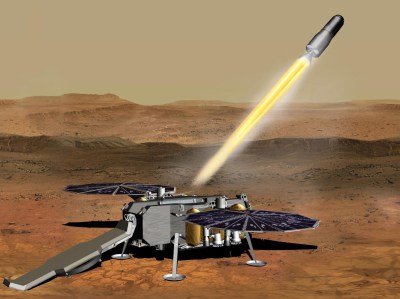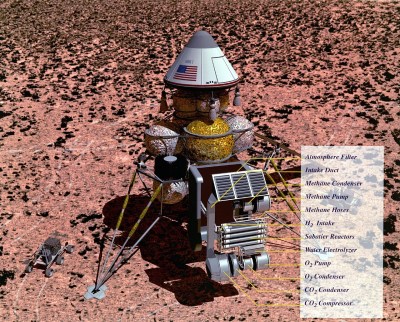Since NASA’s Mariner spacecraft made the first up-close observations of Mars in 1964, humanity has lobbed a long line of orbiters, landers, and rovers towards the Red Planet. Of course, it hasn’t all been smooth sailing. History, to say nothing of the planet’s surface, is littered with Martian missions that didn’t quite make the grade. But we’ve steadily been getting better, and have even started to push the envelope of what’s possible with interplanetary robotics through ambitious craft like the Ingenuity helicopter.
Yet, after nearly 60 years of studying our frigid neighbor, all we have to show for our work boils down to so many 1s and 0s. That’s not to say the data we’ve collected, both from orbit and on the surface, hasn’t been extremely valuable. But scientists on Earth could do more with a single Martian rock than any robotic rover could ever hope to accomplish. Even still, not so much as a grain of sand has ever been returned from the planet’s dusty surface.
But if everything goes according to plan, that’s about to change. Within the next decade, NASA and the European Space Agency (ESA) hope to bring the first samples of Martian rocks, soil, and atmospheric gases back to Earth using a series of robotic vehicles. While it’s still unclear when terrestrial scientists should expect delivery of this interplanetary bounty, the first stage of the program is already well underway. The Perseverance rover has started collecting samples and storing them in special tubes for their eventual trip back to Earth. By 2028, another rover will be deployed to collect these samples and load them into a miniature rocket for their trip to space.

Just last week NASA decided to award the nearly $200 million contract to build that rocket, known officially as the Mars Ascent Vehicle (MAV), to aerospace giant Lockheed Martin. The MAV will not only make history as the first rocket to lift off from a celestial body other than the Earth, but it’s arguably the most critical component of the sample return mission; as any failure during launch will mean the irrevocable loss of all the samples painstakingly recovered by Perseverance over the previous seven years.
To say this mission constitutes a considerable technical challenge would be an understatement. Not only has humanity never flown a rocket on another planet, but we’ve never even attempted it. No matter what the outcome, once the MAV points its nose to the sky and lights its engines, history is going to be made. But while it will be the first vehicle to make the attempt, engineers and scientists have been floating plans for a potential Martian sample return mission for decades.
Soviet Ambition
America might have gotten a probe in orbit around Mars first, but it was the Soviets who successfully put a lander on the surface in December of 1971. The craft only remained active for a few minutes, but it was still a scientific and political triumph. Looking to establish a commanding lead over the US, Soviet engineers wasted no time in planning an ambitious sample return mission. The first phase, Mars 4NM, would test out core concepts and collect data. This would be followed by the Mars 5NM mission, which would drop a colossal 16 metric ton lander on the planet’s surface sometime in 1976.

The incredible mass of the lander, comparable to NASA’s manned Apollo Lunar Module, was due to the fact that it would contain not only the two-stage rocket necessary to lift the collected soil samples from the Martian surface, but also the 750 kilogram (1,650 pound) Mars-Earth return vehicle and the 15 kg (33 lb) spherical reentry capsule. Thanks to the unforgiving nature of the rocket equation, of that 16,000 kg of hardware delivered to Mars, all Soviet scientists would get back in return was approximately 200 grams of soil.
Unfortunately, the massive N1 rocket that was required to loft these heavyweight missions was never completed. Without a booster powerful enough to lift the Martian vehicles in one piece, a modification was proposed that would use several launches to put the hardware into orbit. Fearing the added complexity would doom the already ambitious mission, plans were scaled back drastically. Hardware for this revised Mars 5M mission was under construction in 1978, but a political change of the wind canceled the project as it was deemed too expensive and risky.
NASA’s Shifting Priorities
While American scientists were certainly just as eager as their Soviet counterparts to get their hands on some fresh Martian samples, NASA was never quite able to get a sample return mission past the early concept phases. The desire was there, but the price tag was simply too high considering all the other programs the agency was supporting through the 1980s.

In fact, plans didn’t really firm up until after the 1996 announcement that scientists believed they had found evidence of ancient fossilized bacterium on a Martian meteorite. Although the theory was later discredited, it did put Mars back in the spotlight. Sample return missions were considered by NASA’s Mars Exploration Program and Jet Propulsion Laboratory, and in 2009 NASA and ESA agreed to work together on the ExoMars program, which was designed to bring Martian samples back to Earth sometime in the 2020s.
But the plan was short lived. In 2012, NASA shocked its international partners by dropping out of the ExoMars program to free up additional funds for the James Webb Space Telescope. Without the considerable funding NASA was set to provide, the entire program needed to be restructured. The ESA ultimately partnered with Russia to continue development of the ExoMars lander and rover, albeit with the sample return capability removed, and the mission is currently expected to launch in late 2022.
One Step At a Time
Even though the ExoMars deal fell through, the United States remained committed to conducting a Mars sample return mission, with the National Research Council’s Planetary Science Decadal Survey declaring it a top priority mission for the 2013 to 2022 time period. So it was no surprise when NASA and ESA resumed talks in 2018 to develop a framework by which Martian samples could be returned to Earth. Rather than trying to tackle the problem with one elaborate mission and spacecraft, it was understood that the two space agencies would jointly work on each phase of the program incrementally. Outfitting Perseverance with the hardware necessary to collect the samples was the first step, and now it’s time to work on getting them off the surface.
Over the years, NASA has proposed several designs for the Mars Ascent Vehicle. The most recent literature describes a 2.8 meter (9 ft) long two-stage booster that burns TP-H-3062, a solid rocket propellant used on several previous Mars landers, with electromechanical thrust vector control (TVC) providing pitch and yaw authority and a monopropellant hydrazine reaction control system (RCS) used to control roll during ascent as well as provide full attitude control of the upper stage while in orbit. The booster is designed to put a 16 kg (35 lb) payload into a 343 kilometer (213 mile) orbit with an inclination of 27°, though the proposal notes that some orbital variation is expected due to the uncontrollable nature of solid rocket motors.
The 2,400 kg (5,290 lb) Sample Retrieval Lander, the largest and heaviest spacecraft to ever touch down on Mars, would carry the MAV horizontally. This arrangement will make it easier for the samples to be loaded into the cylindrical capsule in the nose, and would keep the lander’s center of gravity low. Once ready for liftoff, gas-powered pistons will toss the rocket into the air at a rate of approximately five meters per second. Once clear of the lander, the rocket will ignite its first stage motor and assume a more vertical position as it makes its ascent. This unusual arrangement, which JPL calls Vertically Ejected Controlled Tip-off Release (VECTOR), means the MAV will be able to take off regardless of the orientation of the Sample Retrieval Lander.
After reaching orbit, the MAV will be met by the ESA-developed Earth Return Orbiter (ERO). This spacecraft will use a robotic arm to capture the sample canister and place it into the onboard Earth Entry Vehicle (EEV). Once the cargo is secured it will use high-efficiency ion engines to begin the two year journey back to Earth.
Or at least, that’s the plan. The ERO and EEV are currently in the conceptual phase, and while the designs for the MAV and Sample Retrieval Lander are more fleshed out, Lockheed Martin still has years of work ahead of them before the hardware is ready for flight tests here on Earth; to say nothing of getting packed up and sent off to another planet. There’s an incredible amount of work to be done before we bring a piece of Mars back home, and plenty that can go wrong. But after decades of false starts, it looks like we’re finally on the right track.

















Interesting!
“The MAV will not only make history as the first rocket to lift off from a celestial body other than the Earth” – … or the moon, of course 😀 Or was that a hoax?
OSIRIS-REx also.
And Hayabusa, although the landing was not the original intent.
Define ‘rocket’
Man, if the lander doesn’t count as a rocket then my world is rocked.
There’s a lot of room for interpretation here, and obviously we’ve fired rocket engines on the Moon before, but this would be the first “traditional” booster rocket ever flown off-Earth.
They probably should have specified “multi-stage” rocket. (I’m not aware of any that can claim that without really stretching the definition of a stage)
Even then, just because the LEM used a rocket engine to get off the moon, I wouldn’t call it a “rocket”.
Like you said, there’s staging to consider. And the fact that the MAV has to deal with atmosphere (even if its thin) which gives it the classic rocket shape.
It’s the same reason the Ingenuity helicopter is called the first aircraft to fly on another planet, even though the rover it came in on technically performed controlled, powered, flight in the atmosphere.
It kind of seems to me that sample collecting is the Perseverance feature that has been getting the most coverage since it landed. Maybe that’s just what it is spending it’s time doing. Sorry, not sorry, I see this as being the least interesting thing about Perseverance.
It’s not that getting the samples to Earth wouldn’t be great it’s just that I see it about as likely as that return of actual living people to the moon (or anywhere else beyond LEO) that we’ve already waited a lifetime to see. Wake me when they have spend more on building actual hardware than they can politically afford to just throw away.
Yes I would like to see the children born after man first landed on the moon live to see man land on the moon again.
Was the name a deliberate reference to The Martian, or was Andy Weir just good at guessing what space agencies would call such a rocket?
I think it’s more that The Martian was based around Robert Zubrin’s “The Case for Mars”, probably the most famous outline of a realistic mission profile to mars, and Robert Zubrin coined the term MAV (I’m sure he used it before the book, though). This book has also been extremely influential in Mars planning in real life, and though this mission doesn’t follow the same progression of missions (Zubrin is probably screaming about ISRU right now), it’s not surprising that they’re using the same MAV name.
Prediction: In 10 years, Lockheed Martin pays SpaceX $5 for a bucket of Martian dust vacuumed out of the floor mats of the most recently returned-from-Mars Starship, gets accolades from the current {insert party here} administration and is awarded a $2B contract to do the same thing in another 5 years.
Dude – how true!! It’s amusing to see starship ignored. On one hand nasa is depending on starship to work in a couple of years well enough to trust it to land a couple of astronauts on the moon – but leave it out of the picture totally when they talk about sample return.
$5? No, I don’t think so.
Remember the old adage “Just be cause it’s easy for us, doesn’t mean it’s cheap for the customer.”
Starship is an investment scam like hyperloop. It isn’t being taken seriously because it isn’t being developed seriously.
You mean other than NASA literally pinning their entire manned lunar program on it?
Starship was NASA’s last choice but they were forced to go with it due to budget and bidding rules. Anyone can win a contract by massively under bidding it. Elon is just going to take the money and run.
On the off chance you aren’t Bezos in disguise, they don’t just hand the money over. The contractor demonstrates progress before they get a progress payment.
Falcon 9 has been highly successful and has brought down launch costs massively. It got people to the ISS a lot more cheaply than Boeing is trying to do and actually works. SpaceX has been working on Starship a lot longer than they’ve been getting money from the HLS.
Hi Jeff, please don’t let us think you have nothing better to do than troll here.
I came to say what Dave already said about the moon hoax, so instead:
Haven’t we already had Martian meteorites land on Earth? (277 so far…. that we know of)
Martian meteorites that experienced a cataclysmic event to get them to Mars escape velocity, spent a millennium or ten in space, and experienced an unprotected rentry into the Earth’s atmosphere and an energetic impact with the surface, not to mention potentially centuries of exposure to Earth contamination.
Scientifically useful, but not as much as pristine samples.
Yes, fresh is better.
Ummm what about those meteoric materials from mars they keep finding here on earth?
Maybe they want samples that have not been cooked at hundreds (thousands?) of degrees F?
What does that have to do with anything? An ancient BBQ’d rock is not the same as soil, atmosphere, and perhaps even water/ice samples pulled from current-day Mars.
@Piotrsko said: “Ummm what about those meteoric materials from mars they keep finding here on earth?”
meteoric > meteoritic
Is it just me, or does NASA just like doing things the hard way? Designing one spacecraft to land and take samples, and another to go land right next to it, somehow retrieve the samples, transfer these to ANOTHER spacecraft waiting in Mars orbit, and return to Earth seems a bit Rube Goldberg. Why not just send a spacecraft that on landing jams a hollow spike into the ground, then boosts back? Or at least something SOMEWHAT simpler.
The latest round of Mars missions seem to be showing that … let’s call them “daring” schemes are paying off. It started with deliberately lithobraking and escalated to landing a rover by lowering it from a skyhook.
Ares seems to favor the bold.
What else could you expect from a god of war?
A dedicated spacecraft to return samples will be much lighter and use less fuel for the return trip. There is no need to carry a drill bit, landing legs, retro rockets, cameras, etc… back with it. This is called engineering.
Funding?
The current river was already funded, so, you only have to get permission for strapping in an extra thing (drill & storage) rather than a dedicated mission.
Now they have the leverage of 1) the publicity it has gotten, and 2) it’s sitting there ready for pickup, so that is incentive to actually do the second half.
I think the article mentioned a small purpose-built rover for the intent of collecting the samples and bringing it to the rocket. Yes it’s an extra rover, but nasa loves their rovers.
Can we at least make them clear on what measurment systems they’re supposed to use this time? https://www.simscale.com/blog/2017/12/nasa-mars-climate-orbiter-metric/
How about Babylonian Cubits just for fun!
So SpaceX was no bid?